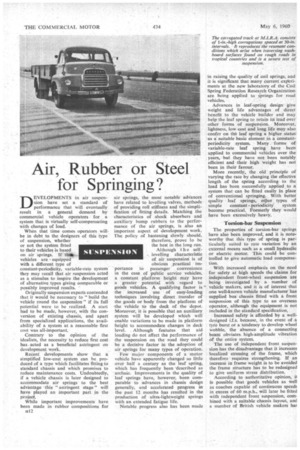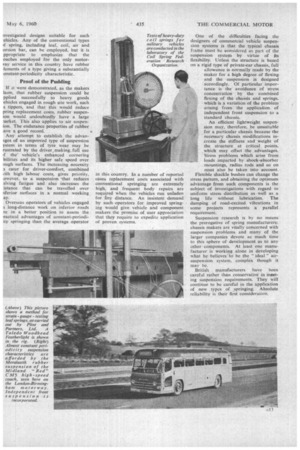Air, Rubber or Steel for Springing?
Page 126

Page 127

If you've noticed an error in this article please click here to report it so we can fix it.
DE'VELOPMENTS in air suspension have set a standard of performance that will eventually result in a general demand by commercial vehicle operators for a system that is virtually self-compensating with changes of load.
When that time comes operators willbe in debt to the designers of this type of suspension, whether or not the system fitted to their vehicles is based on air springs. If -WO vehicles are equipped with a different type of constant-periodicity, variable-rate system they may recall that air suspension acted as a stimulus to inspire the development of alternative types giving comparable or possibly improved results. "
Originally suspension experts contended that it would be necessary to "build the vehicle round the suspension" if its full potential were to be realized. A start had to be made, however, with the Conversion of existing chassis, and apart from specialized applications, the availability of a system at a reasonable first cost was all-important. _
Contrary to the opinion of the idealists, the necessity to reduce first cost has. acted as a beneficial astringent on development work.
Recent developments show that a simplified low-cost system can be produced of a type which facilitates fitting to standard chassis and which promises to reduce maintenance costs. Undoubtedly, if a vehicle chassis is later designed to accommodate air springs to the best advantage this "astringent stage" will have played an important part in the project.
While important improvements have been made in rubber compositions for Frl 2
SUSPE
air springs, the most notable advances have related to levelling valves, methods of providing roll stiffness and the simplification of fitting details. Matching the characteristics of shock absorbers and auxiliary bump rubbers to the performance of the air springs, is also an important aspect of development work. The policy of hastening slowly, should, therefore, prove to be the best in the long run.
Although the selflevelling characteristic of air suspension is of obvious _practical importance to passenger convenience in the case of public service vehicles, a constant platform height may have a greater potential with regard to goods vehicles. A qualifying factor is the increased use of easy-loading techniques involving direct transfer of the goods or body from the platform of the vehicle to the deck of the depot. Moreover, it is possible that an auxiliary system will be developed which will enable variations to be made in platform height to accommodate changes in deck level. Although features that aid loading do not affect the performance of the suspension on the road they could be a decisive factor in the adoption of air springs for many types of operation.
Few major components of a motor vehicle have apparently changed so little over half a century as the leaf spring, which has frequently been described as archaic. Improvements in the quality of leaf springs have, however, been comparable to advances in chassis design generally, and accelerated progress in the past 12 months has resulted in the production of ultra-lightweight springs with an extended fatigue life.
Notable progress also has been made
INSION
in raising the quality of coil springs, and it is significant that many current exp‘eriments at the new laboratory of the Coil Spring FederatiOn Research Organization are being applied to springs for road vehicles.
Advances in leaf-spring designgive weight and life advantages of direct benefit to the vehicle builder and may help the leaf spring to retain itS lead over other forms of suspension. Moreover, lightness, low cost and long life may also confer on tlfe leaf spring a higher status as a: suitable basic element in a constantperiodicity system. Many forms of variable-rate leaf spring have been applied to commercial vehicles over the years, but they have not been notably efficient and their high weight has not been in their favour.
More recently,, the old principle of varying the rate by changing the effective length of the spring according to the load has been successfully applied to a system that can be fitted easily in place of conventional springing. With better quality leaf springs, °tiler types of simple constant periodicity system become practical. Formerly they would have been excessively heavy.
Torsion-bar Suspension
The properties of torsion-bar springs have also been improved, and it is noteworthy that this type of spring is particularly suited to rate variation by an external means such as a small hydraulic or electric motor. This could be controlled to give automatic load compensation.
With increased emphasis on the need for safety at high speeds the claims for independent front-wheel suspension are being investigated by a number of vehicle makers, and it is of interest that one well-known vehicle manufacturer has supplied bus chassis fitted with a front suspension of this type to an overseas operator, although the equipment is not included in the standard specification.
Increased safety is afforded by a welldesigned if.s. because, in the event of a tyre burst or a tendency to develop wheel wobble, the absence of a connecting beam obviates high-amplitude vibration of the entire system.
The use of independent front suspension has the disadvantage that it increases localized stressing of the frame, which therefore requires strengthening. If an increase in frame weight is to be avoided the frame structure has to be redesigned to give uniform stress distribution.
According to authoritative opinion, it is possible that goods vehicles as well as coaches capable of continuous speeds in excess of 60 m.p.h., will later be fitted with independent front suspension, combined with a suitable chassis layout, and a number of British vehicle makers ha..! nvestigated designs suitable for such ehicles. Any of the conventional types if spring, including leaf, coil, air and orsion bar, can he employed, but it is ppropriate to emphasize that the °aches employed for the only motorray service in this country have rubber lements of a type giving a substantially oristant-periodicity characteristic.
Proof of the Pudding If it were demonstrated, as the makers laim, that rubber suspension could be pplied successfully to heavy goods ehicles engaged in rough site work, such s tippers, and that this would reduce pring replacement costs, rubber suspenion would undoubtedly have a large narket. This also applies to air suspenion. The endurance properties of rubber ave a good record.
Any attempt to establish the advantges of an improved type of suspension ystem in terms of tyre wear may be rustrated by the driver,.making.full use if the vehicle's enhanced .cornering bilities and its higher safe speed over ough surfaces. The increasing necessity 3 cater for driver-comfort, combined lith high labour costa, gives priority, .ow-ever, to a suspension `that reduces riving fatigue and also increases the istancc that can be travelled over nferior surfaces in a normal working ay.
Overseas operators tif vehicles engaged a long-distance work on inferior roads re in a better position to assess the Tactical advantages of constant-periodiity springing than the average operator in this country. In a number of reported cases replacement costs associated with conventional springing are extremely high, and frequent body repairs are required when the vehicles run unladen for Any distance. An insistent demand by such operators for improved springing would give vehicle and component makers the promise of user appreciation that they require to expedite application of proven systems.
One of the difficulties facing the designers of commercial vehicle suspension systems is that the typical chassis frame must be considered as part of the suspension system by virtue of its flexibility. Unless the structure is based on a rigid type of private-car chassis, full allowance is normally made by the maker for a high degree Of flexing and the suspension is designed accordingly. Of particular.importance is the avoidance of stress concentration by the combined flexing of the chassis and springs, which is a variation of the problem arising from the application of independent front suspension to a standard chassis.
An efficient lightweight suspension may, therefore, be unsuitable for a particular chassis because the necessary chassis modifications increase the stiffness and weight of the structure at critical points,
• which may offset the advantage's.•
• Stress problems which arise from loads imparted by shock-absorber mountings, radius rods and so on must also be taken into account.
Flexible shackle bushes can change the stress pattern, and obtaining the optimum advantage from such components is the subject of investigations with regard to uniform stress distribution as well as a long life without lubrication. The damping of road-excited vibrations in some projects represents a parallel requirement.
Suspension research is by no means the prerogative of spring manufacturers: chassis makers are vitally concerned with suspension problems and many of the larger companies devote as much time to this sphere of development as to any tither components. At least one manufacturer is working alone in developing what he believes:io be the "ideal" airsuspension system, complex though it may be.
British manufacturers have been careful father than conservative in meeting suspension requirements. They will continue to be careful in the application of new _ types of springing. Absolute reliability is their first consideration.




































































































































































































































































